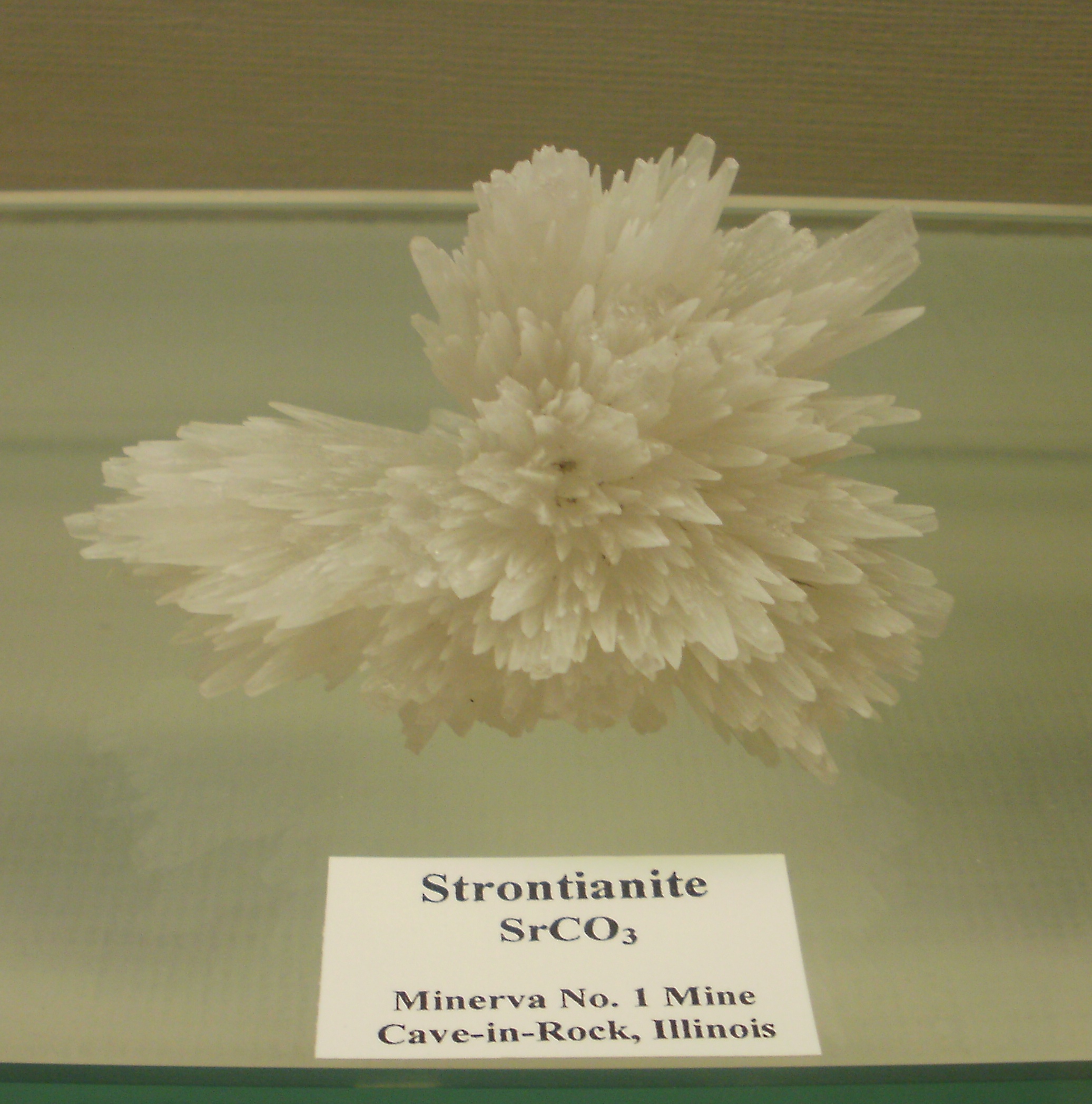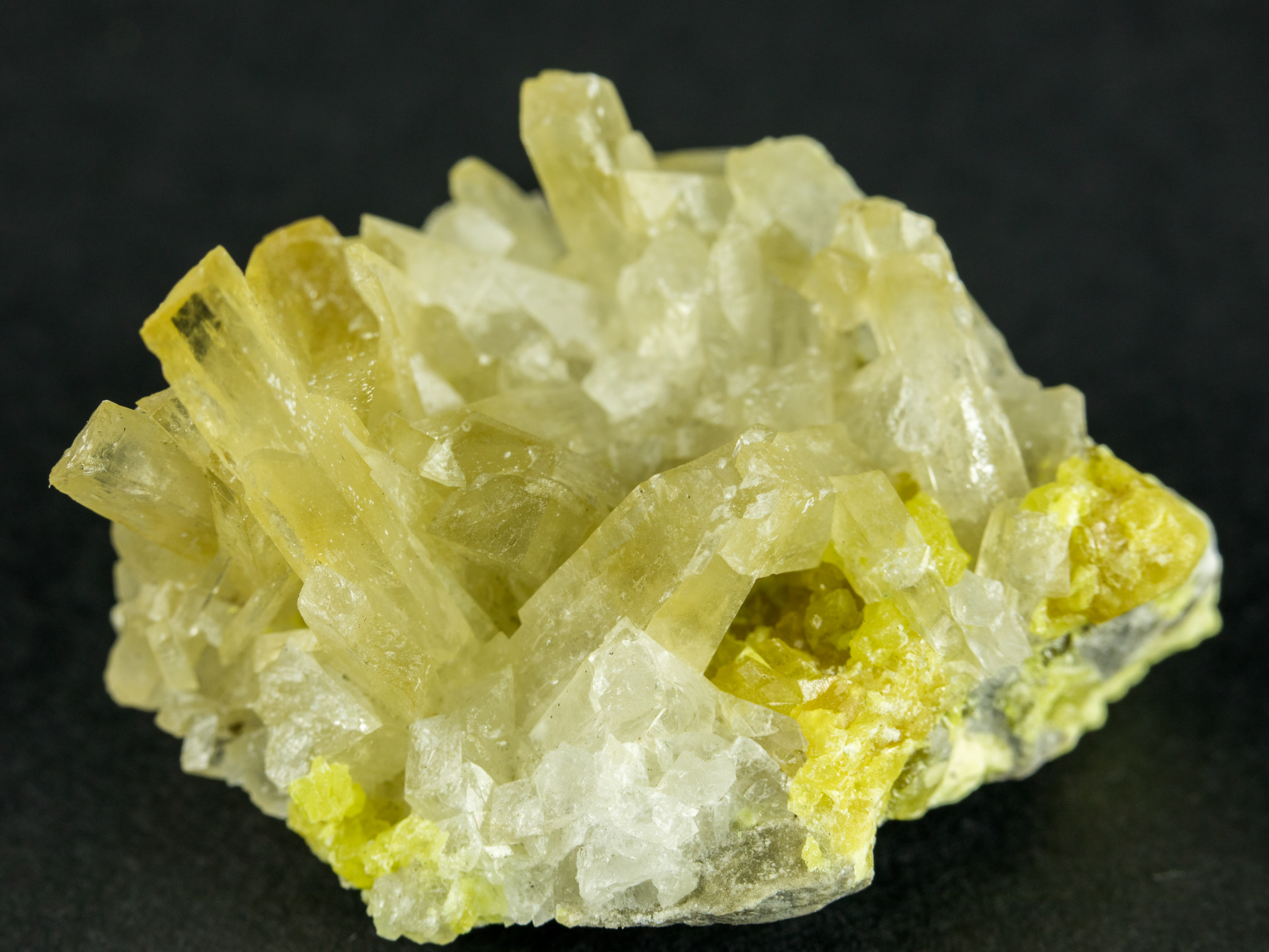Strontianite Gemstone: Properties, Meanings, Value & More
Strontianite is a rare gemstone that’s usually white or light greenish-yellow. Is strontianite a rock or mineral? It’s a mineral and one of the few containing strontium.
As a gemstone, strontianite is quite uncommon and pretty much only known among collectors. The stone is better known for its industrial properties.
What is the meaning of strontianite? Metaphysically, strontianite represents tranquility, spirituality, and balance.
Ready to find out more? Join us as we fill you in on all of strontianite’s properties, prices, history, and more!
 Pictured above: Strontianite specimen with sulfur | Image credit: Ra'ike, CC-BY-SA-3.0
Pictured above: Strontianite specimen with sulfur | Image credit: Ra'ike, CC-BY-SA-3.0
About Strontianite Stone
Strontianite is a rare semi-precious gemstone also known as:
Stronthianite
Strontian
Strontian Spar
Emmonsite
You may mix up strontianite with strontium titanate. Also known as Fabulite, Marvelite, and Diagem, strontium titanate is a synthetic stone meant to imitate diamond. While not as widespread now, this stone was quite popular from the 1950s to 1970s.
Strontianite Uses
Industrially, what is strontianite used for? First and foremost, strontianite is one of the two principal sources of strontium (along with celestite). Strontium is only found in nature as compounds with other elements.
Scientists can extract the strontium from these stones by treating them with hydrochloric acid to make strontium chloride, which is combined with potassium chloride, melted, and electrolyzed. The result is chlorine gas and strontium. They can also obtain strontium by reducing strontium oxide with aluminum.
Strontium is important for making:
Cell phone circuit boards
Iridescent glass
Sensitive-teeth toothpastes
Cancer treatment dietary supplements (beta emitters)
Glaze refining for ceramics
“Glow-in-the-dark” plastics & paints
Pyrotechnics like red fireworks & flare guns
Medications for osteoporosis & tooth decay
Magnets
Fun fact: the current most precise atomic timepiece is a strontium atomic clock, which uses a strontium isotope called strontium 87. The clock is so precise, it will only lose 1 second about every 15 billion years — for reference, most quartz clocks lose 1 second every 2 years or so.
Strontium carbonate specifically has been used to make cathode ray tube (CRT) glass, which was previously used in televisions to prevent exposure to X-ray emissions. This use has become somewhat obsolete with the popularity of flat screen TVs.
 Pictured above: Strontianite specimen with intergrown, connected balls and glassy needles | Rob Lavinsky, iRocks.com – CC-BY-SA-3.0
Pictured above: Strontianite specimen with intergrown, connected balls and glassy needles | Rob Lavinsky, iRocks.com – CC-BY-SA-3.0
Strontianite Specifications & Characteristics
What is strontianite made of? This mineral is composed of strontium carbonate, so the strontianite formula is SrCO3. However, up to 27 percent of the strontium can be substituted by calcium and up to 3.3 percent can be substituted by barium.
Most strontianite specimens contain some calcium, and calcium-bearing strontianite may be called “emmonite.” More calcium content makes strontianite’s density lower, while lead or barium impurities make strontianite denser.
The stone is in the aragonite group of orthorhombic carbonates beside aragonite, witherite, and cerussite. Strontianite forms two series with aragonite (calcium carbonate) and witherite (barium carbonate).
Strontianite crystals can be prismatic, acicular (needle-like), columnar, or pseudo-hexagonal. You’ll see horizontal striation on the crystal’s prism faces. Many crystals also narrow into fans or sprays. Additionally, the mineral can occur as columnar, rounded, or fibrous masses.
Twinning is very common in strontianite. Most are contact twins, and penetration twins are rare but may occur. Strontianite twins can be polysynthetic (repeated twinning with three or four parallel-aligned crystals), trillings (three intergrown crystals making a hexagonal shape), or fourlings (four intergrown crystals).
Strontianite properties listed:
Mohs hardness: 3.5
Color: Colorless, white, gray, light yellow, light green, pale red, brown; May be color-zoned
Crystal structure: Orthorhombic
Luster: Vitreous; Resinous on breaks, greasy on fractures
Transparency: Transparent to translucent
Refractive index: 1.52-1.67
Density: 3.63-3.79; May vary with strontium content
Cleavage: Nearly perfect on {110}, Poor on {021}, Traces on {010}
Fracture: Subconchoidal or uneven
Streak: White
Luminescence: Fluorescence almost always present - bright yellowish-white, white, olive green, or blue-green in SW-UV & LW-UV; Usually phosphorescent; Sometimes thermoluminescent; X-ray colors - fluorescent and phosphorescent
Pleochroism: None
Birefringence: 0.090-0.150
Dispersion: 0.008-0.028 (weak)
Pictured above: Isomorphous minerals in Royal Belgian Institute of Natural Sciences, in Brussels (Belgium) | Image credit: Fernando Losada Rodríguez, CC-BY-SA-4.0
Strontianite History
German physician Friedrich Gabriel Sulzer published the first description of strontianite in 1791. While it’s clear the mineral was named after where it was first discovered (Strontian, Scotland), it’s unclear who officially chose the name.
In 1787, Irish chemist Adair Crawford discovered an unusual witherite stone in Strontian. (For context, witherite’s first description was in 1784). Crawford mixed witherite with hydrochloric acid, but the confusing results made him think a new mineral was inside the witherite. He named the mineral “strontia.”
In 1791, Scottish chemist Thomas Charles Hope officially discovered strontium from a strontianite mineral when he found that the strontium became red under a flame. English chemist Sir Humphry Davy isolated strontium successfully in 1808 via electrolysis.
However, many sources claim that the name “strontianite” came from Sulzer in 1791. In the article, German physician Johann Friedrich Blumenbach presents a letter from Sulzer with evidence that strontianite is distinct from witherite and contains the new element strontium.
In 1849, French chemists Hippolyte Leplay and Augustin-Pierre Dubrunfaut started using strontianite instead of barium oxide to extract sugar from the molasses of sugar beets.
German chemist Carl Scheibler refined the process (no pun intended) for industrial use, leading to a huge increase in strontianite mining. The method became known as the “Strontian process.”
However, the significantly lowered prices of sugar and the cheaper alternative to strontium (celestite) caused strontianite demand to lower by 1883 and the Strontian process became obsolete.
Strontianite Crystal Healing Properties
As a commonly colorless healing stone, strontianite’s meaning reflects the cleansing and protective properties of other white gemstones.
Other purported strontianite metaphysical properties include being a crown chakra stone, helping with calcium absorption, and promoting mental clarity.
 Pictured above: Jackstraw nest of strontianite crystals | Image credit: Rob Lavinsky, iRocks.com – CC-BY-SA-3.0
Pictured above: Jackstraw nest of strontianite crystals | Image credit: Rob Lavinsky, iRocks.com – CC-BY-SA-3.0
Strontianite Gemstone Properties
In addition to their rarity, strontianite gemstones are valued based on their color, cut, clarity, transparency, and carat weight.
Color
Many strontianites are white or colorless, which may be somewhat attractive if the color is pure. The stone can also be gray, yellow, yellow-green, red, or brown. The colors are usually pale and some crystals have vertical color-zoning.
Cut
Gem-quality strontianites are rare, and combined with their fragility means any cut strontianites are fairly valuable. One downside to faceted strontianites, however, is that the high birefringence results in facet doubling and lowers sparkle.
Most strontianites are sold as rough (uncut) specimens. Some are tumbled, carved, or cut into cabochons, often specimens mixed with other minerals like aragonite.
Clarity & Transparency
Clarity is the degree of visible inclusions in a gem, which can affect its transparency and value. Visible inclusions aren’t incredibly significant for strontianite’s value, but they can affect its durability. Many stones have fluid inclusions.
Higher transparency usually means higher value. More transparent strontianites may also be denser.
Strontianite is often an inclusion inside of fluorite.
Carat Weight & Size
Most faceted strontianite gems are tiny, with the largest commercial options typically around 2-4 carats.
Particularly large rough specimens with few flaws can command high prices.
 Image credit: Chris857, CC-BY-SA-3.0
Image credit: Chris857, CC-BY-SA-3.0
Strontianite Formation & Sources
Strontianite is a low-temperature hydrothermal mineral, meaning it forms when hot water containing dissolved elements (in this case, strontium and carbon) settles into cavities or veins inside rocks. The water evaporates, and the elements crystallize, likely at low pressures and fairly low temperatures.
The stone is usually found within veins of limestone, chalk, carbonatites, and marl, along with cavities of lava rocks and rarely hydrothermal metallic veins. It also occurs as geodes or concretions. Strontianite can alter into celestite, but celestite can also alter into strontianite.
Common associates are:
Mining Locations
Geographically, where can you find strontianite? The majority of facetable crystals have come from Germany and Austria. Other significant strontianite sources include:
Canada
India
Italy
Mexico
Russia
UK (Scotland & England)
USA (California, Illinois, Kentucky, Louisiana, New Mexico, New York, Ohio, South Dakota, Texas, Virginia, Washington)
Ready to shop? Then let’s go over what prices to expect.
 Pictured above: Strontianite and sulfur crystal specimen | Image credit: © Raimond Spekking / CC BY-SA 4.0 (via Wikimedia Commons)
Pictured above: Strontianite and sulfur crystal specimen | Image credit: © Raimond Spekking / CC BY-SA 4.0 (via Wikimedia Commons)
Strontianite Price & Value
Despite their rarity, strontianite stones come at a range of prices, many of which are affordable. Of the few faceted strontianite gems available, some are as low as $25 per carat.
The prices for rough strontianite have the broadest range. Many specimens are combined with minerals like fluorite or celestite.
The priciest rough strontianite crystal specimens are around $300 to $1,000, with the occasional specimen reaching $4,500. However, plenty of strontianite crystals are available for about $10 to $50 each.
Strontianite Care and Maintenance
Firstly, is strontianite toxic? The stone has a low toxicity risk due to its strontium content. Just avoid inhaling or ingesting a lot of strontianite dust or particles, and wash your hands after handling the stone if it’s uncut.
In terms of gemstone care, keep strontianite away from hydrochloric acid and mechanical cleaning systems (e.g. ultrasonic or steam cleaners).
Clean the stone with warm, soapy water and a soft toothbrush.
Feeling Strongly About Strontianite?
A rare collector’s gem, strontianite may be better known for its industrial uses, but the soft colored crystals are a calming, beautiful addition to any space or rare mineral collection.
Was this article helpful?
1 person found this article helpfulRoss Sedawie
- Written - 10th Jul 2023
- Edited - 3rd Sep 2023
















